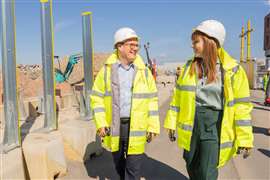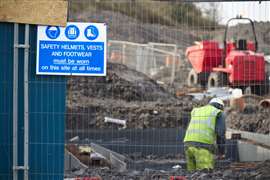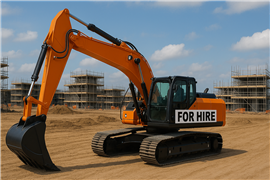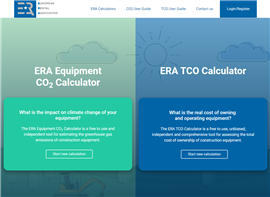Will the UK’s infrastructure drive spell growth for rental companies?
15 May 2025
UK prime minister Kier Starmer has pledged to boost infrastructure investment in the country, promising to run a government “for the builders, not the blockers.” But will this really mean increased construction activity on the ground - and what does it mean for the rental sector? Lewis Tyler investigates.
 UK prime minister Kier Starmer and deputy prime minister Angela Rayner tour a building site. Photo: Kier Starmer (via Facebook)
UK prime minister Kier Starmer and deputy prime minister Angela Rayner tour a building site. Photo: Kier Starmer (via Facebook)
When UK prime minister Kier Starmer swept to power last year he promised to run a government “for the builders, not the blockers.”
For the country’s ruling Labour Party, investing in the construction of new infrastructure is a key part of its plan to kickstart the ailing economy. It has pledged to build 1.5m homes, decarbonise the electricity grid within five years; and build out megaprojects, including a new rail line connecting Oxford to Cambridge; and a third runway at Heathrow.
For the the UK construction sector, which has been struggling following two years of depressed activity - and its plant hire suppliers - Starmer’s promises offer hope.
According to data company Barbour ABI, the country’s plant hire sector is set to grow by 14.3% over the next four years, reaching £4.07 billion in 2029, fuelled by growing demand from infrastructure and energy sectors.
 A construction work site and safety insignia Image: Adobe Stock
A construction work site and safety insignia Image: Adobe Stock
The company predicts a spike in demand for rented construction equipment supported by a projected £700–£775 billion in UK infrastructure investment and a growing push for low-emission equipment.
Ed Griffiths, chief analyst at Barbour API says growth will be driven by major infrastructure upgrades including the ongoing HS2 high speed rail link, AMP8 – a combined GB£104 billion investment plan for water companies, and The Great Grid Upgrade – a GB£60 billion plan to upgrade national electricity networks.
But so far the reality for most contractors – and their equipment rental suppliers – remains far more muted.
A bounce back in the final three months of 2024 for the UK construction industry fizzled out and so far this year, concerns about the impact of Donald Trump’s import tariffs and government red tape have further delayed decision making.
Construction data specialist Glenigan reported a sharp drop in major project starts in its February 2025 Construction Review with total project values down 19% year on year in the quarter to January.
According to Barbour ABI, annual growth levels for the UK rental sector as a whole shrank to just 2% over the last year as political uncertainty and rising costs acted as a drag on confidence.
 Photo: Barbour ABI
Photo: Barbour ABI
KPMG, also predicts a moderate expansion in the total UK plant hire sector of around 2.5% in 2025, Martin Seban, a director for mid-market strategy, noted at the ERA Convention in Lisbon.
It’s a picture reflected in the financial results of some of the UK’s largest rental companies too.
In February, Speedy Hire warned that its full year profits were expected to be lower than anticipated because of a “challenging” start to the final quarter of its financial year.
The company said that after a promising third quarter, with hire revenue for December 5% higher year-on-year, trading slowed again in January amid a wider economic downturn.
HSS reported a 2% year-on-year decline in like-for-like revenues for the 12-month period ending 30 December 2024, with the company citing tough market conditions and a changing sales mix.
Revenues for the period were £333 million (excluding the power business that it sold in March 2024), while its gross margin also fell from 47.0% to 45.2%.
Meanwhile Vp plc, the parent of Brandon Hire Station, another major player in the UK market, announced in December that although total group revenues for the half year increase by 1% to GB£192.5 million, both revenues and operating profits in the UK were down.
The company reported strong activity levels in water projects and power transmission upgrades, although it said activity in railways was slower than expected.
Long term growth
Yet, even if many of these promised infrastructure upgrades never materialise, Barbour ABI predicts that the UK rental industry will still continue to grow in the long term as more and more contractors opt to rent equipment rather than owning it.
As a country where the lion’s share of large contractors already choose to rent rather than buy or lease machinery, Barbour ABI predicts that numbers will climb further.
The company estimates that rental penetration in the country stands at around 75% and expects this to climb higher as cash strapped contractors opt to reduce capital expenditure.
Griffiths says the main factors driving this trend are cost pressures and tightening environmental legislation which is forcing firms to upgrade fleets rapidly.
“Hiring gives firms the ability to scale up quickly for major infrastructure or energy projects, while avoiding the financial and legislative burden of plant ownership,” he says.
Barbour ABI estimates that earthmoving and lifting equipment account for 68% of the total hire market.
“The shift to smart, sustainable, and flexible solutions will define how construction firms operate over the next five years,” Griffiths says.
The benefits of the UK rental sector
According to a report by the Construction Plant-hire Association (CPA) and Oxford Economics, in 2022, the sector employed about 88,600 workers and indirectly accounted for 44,800 jobs through supply chain purchases, particularly in manufacturing (9,600), administrative services (7,700), and retail and wholesale (7,200).
It found that the sector contributed some £14 billion Gross Value Added (GVA) to the UK economy in 2022, of which £10.5 billion came from UK firms, supporting £6.4 billion in GDP through wages, business profits, and production taxes.
STAY CONNECTED



Receive the information you need when you need it through our world-leading magazines, newsletters and daily briefings.
CONNECT WITH THE TEAM









